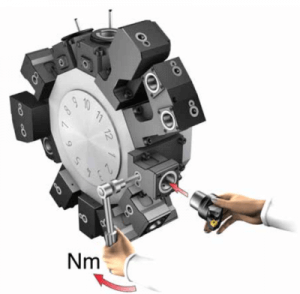Modular tooling and Quick change tooling – what is the difference ?
The terms modular and quick change are often confused.
1. Modular tooling may not have any capability for quick change.
2. Quick change tooling on the other hand is always modular.

Pic. source: www.sandvik.coromant.com
On machining centers, a modular tooling system is more important than quick change tooling systems. This is because tool setup is done offline, on tool pre-setters. You are not bothered so much about the time of changing tools because there is no machine down time involved in this for getting tool offsets. However, the variety of tools and applications tends to be very large. You need flexibility and the ability to build your own tools. Modular tooling has a common set of building blocks that enable you to build multiple tools for different applications and of different lengths. This reduces the cost of tooling, and the lead time to make special-purpose tool holders.

Pic. source: www.sandvik.coromant.com
On lathes, a Quick change tool holder system is very important in reducing machine downtime time for setup changes and for changing worn inserts. Each setup would normally involve fine tuning tool offsets by taking trial cuts, often with the offsets adjusted to leave more material on the part so it does not get scrapped. This is eliminated with quick change tooling. Changing worn out inserts too would normally consume time, both for changing the insert and possibly getting tool offsets again. With quick change tooling you just keep standby heads ready with the insert clamped, and just replace the whole head.
Text source: Cadem NCyclopedia multimedia CNC training software.
Etc
Late lunch (or early dinner) at Dolma House, Delhi
Wandering around Majnu ka Tilla’s Tibetan colony in Delhi at 4 PM, I heard a loud growl. I looked around to see if it came from one of the numerous stray dogs, but they were all sleeping peacefully, it being late afternoon. It turned out that the growl was from my stomach, so I walked into the nearest Tibetan restaurant, a place called Dolma House (Dolma is a common Tibetan female name).

Most of the menu was familiar Chinese dishes, but I (being a strong believer in the dictum “If it looks familiar, don’t eat it”) zeroed in on the Tibetan ones, selected a Thukpa and some Momos.



Thukpa is a noodle soup with a whole lot of vegetables and meat, a meal in itself – ‘Thuk’ means noodles. Based on the shape of noodles, you have two varieties of Thukpa: Gyathuk, with the more familiar long thread noodles, and Thenthuk, with flat noodles.

One normally orders a soup as a starter, but the Thukpa was a really large portion, and my starter became the ender too. I just about managed to stuff the momos into my alimentary canal, and staggered out of the restaurant feeling happy, both with the meal itself and its reasonable price.


